The death of Pope John Paul II led many of different faiths and of no faith to acknowledge their debt to the Roman Catholic Church for holding on to absolutes that the rest of us can measure ourselves against. (Suzanne Fields)
How to Get Sunburned in the World’s Smallest Country
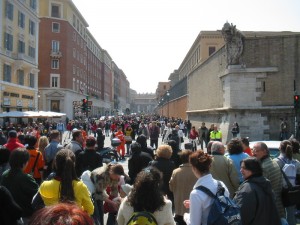
Already the crowds were gathering.
People poured out of the Metro station. Clumps and knots and streams of people were sucked out of Rome’s mazy neighbourhoods towards Piazza San Pietro, drawn swirling through the streets as if by a neutron star that had interrupted its cosmic wanderings to pause and rest a moment at Vatican City.
It was crazy.
(I will note parenthetically that as the week wore on, it only got worse. If you’d have asked me Monday, I’d have flat told you the notion was ridiculous. And yet, the crowds continued to swell exponentially until by Friday the pilgrims outnumbered the Romans by a million or more.)
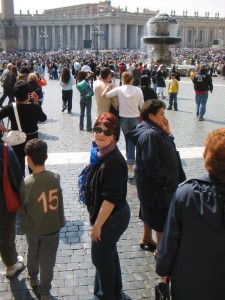
Francine and Cara were having none of it. Francine suffers from claustrophobia. She took one look at the queue (an Italian queue, meaning a barely contained mob), and decided that she and her niece would much rather spend the afternoon shopping.
So we made plans to meet later.
Plan A: 17:00 at the fountain in Piazza de Spagna
Plan B: 19:00 at the flat (to see Cara off to the airport)
Now. Quiz time: what is it about plans and Rome?
So there I was, alone in Rome with maybe ten words of Italian, most of which coalesced into the two related thoughts of “I don’t speak Italian” and “do you speak English?” No troubles.
It just occurred to me that the second sentence is fairly useless in Italian. Hi ho.
I got into line. Quite suddenly, the line dispersed. Confusion.
A lovely couple from Texas provided the answer. Apparently this was the regular “visiting the basilica, tourist style” line, and Vatican security was now clearing out the basilica. The honeymooning Texans had been scheduled for a tour of the Vatican crypts. Cancelled.
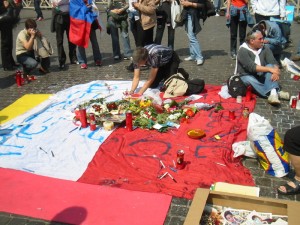
The piazza was divided by barracades into rough quarters, with alleyways in between. We went to one of the quarters closest to the basilica steps.
Slowly, a cadre of English speakers gathered around us. There was the lady from Iowa who had flown in that morning and walked from her hotel immediately here. There were two college girls from California on Spring Break. There was an Englishmen who spoke halting Spanish, and his Spanish friend who spoke halting English and Italian. At last, we were able to talk in a meaningful way (even if third-hand) with the security forces.
Turns out, they didn’t have any idea of what was going on either.
As the afternoon wore on, the Texans left to catch their train to Venice. They may have been the last who left. Oh others tried, but the Great Minds managing security had set up a cordon under the Bernini colonnade. It was, by now, difficult to get into the piazza, but it was flat impossible to get out.
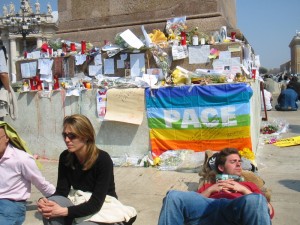
Volunteers from all over Italy, wearing the ubiquitous neon-orange security vests, were handing out bottles of water. This being Italy, it was carbonated.
I got a sunburn, and I wasn’t the only one.
By now the crowd was beginning to approach Metro density. You couldn’t bend down to tie your shoes. My legs, already fatigued from three days of walking, were fairly screaming.
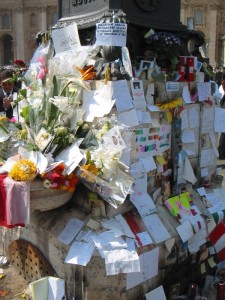 A little girl, maybe six or seven years old, began to chant, “GioVANni PAUlo”, and the crowd would answer with a rhythmic clapping, clap-clap clap CLAP clap clap. Over and over, call and response.
A little girl, maybe six or seven years old, began to chant, “GioVANni PAUlo”, and the crowd would answer with a rhythmic clapping, clap-clap clap CLAP clap clap. Over and over, call and response.
She kept it up for over an hour, and the crowd kept up with her. After a while, she was so tired that her parents carved out enough space to lay her down with an umbrella.
Even flat on her back, she led the crowd, “GioVANni PAUlo!” (clap-clap clap CLAP clap clap)
And still, the crowd grew. Flags appeared in the throng, mostly Polish, but also Mexican, Spanish, Italian, Austrian, American, Brazilian…
Something Happened
News crews magically appeared along the tops of the colonnade and on the roofs of the Papal apartments. Giant video screens on either side of the piazza flicked to life, showing the Pope lying in state in the Sistine Chapel.
I looked at my watch. Even if there was any chance of getting out of the piazza, I still wouldn’t make my Plan A rendezvous with Francine.
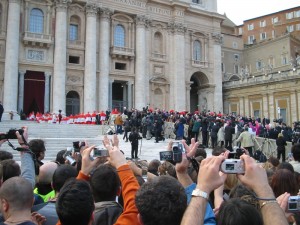
The reason for quartering the piazza with barricades now became obvious: the corridors between were for the procession. Slowly, slowly they came up the steps and filed into the basilica. Thousands of arms shot into the air with cameras.
When the pallbearers got to the entrance, they slowly turned around and tilted the bier so the massive crowd could get one good look at their Pope.
The applause rolled through the piazza like the swell of the sea.
From somewhere to my left, I heard the plaintive voice of a young girl start up her chant, “GioVANni PAUlo!” The crowd responded.
And then the pallbearers slipped into the basilica. Moments later, the Swiss Guard followed. The video screens went black. Show over.
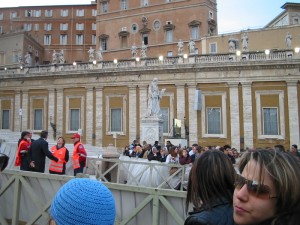
Most of the people who left couldn’t actually leave the piazza. There was nowhere for them to go. By now the crowds were backed up down the avenue as far as you could see.
We waited.
The Sun Set Behind St. Peter’s
It was by now past seven in the evening; I had missed the Plan B rendezvous. There wasn’t particularly a Plan C.
More water was distributed, and a knot of volunteer security began to form in front of the barricades. In the by-now traditional absence of actual information, rumours plied the crowd.
They weren’t going to let us in.
They were going to let us in, starting at nine.
They weren’t going to let us in until tomorrow.
They were going to start with the right-hand quadrant and proceed clockwise (meaning the even though we were in front, we would be last).
Nobody knew. By now, the uniformed security men were just shrugging off questions and smiling. Insufferable bastards.
Eight o’clock. Floodlights were on now in the piazza. The density of the crowd seemed to increase. I looked back: they were letting people from the avenue into the piazza. The only way out now was clearly through the basilica.
Eight thirty. The video screens came to life, showing an aerial shot of the piazza and the staggering crowd. The camera pulled back, and you could now see the crowd outside was just as big. Still the camera pulled back, and the crowd snaked through the city for kilometers.
Once again, the crowd roared, and I could feel it in my lungs, in my bones.
Volunteer security climbed over the front barricades and spread out into the crowd, eventually forming a rough rectangle around perhaps fifty of us.
While we were distracted with this, uniformed security let through a group of about a dozen handicapped people – folks in wheelchairs or with braces or crutches.
Then they opened the gate and let in the fifty of us.
As I climbed the steps of the basilica, I turned around to survey the crowd. There were perhaps twenty people ahead of me, but there were a million behind me.
So the lady from Iowa and I entered St. Peter’s basilica. It’s enormous, two football fields long and a football field high. And it was dark, lit only by candle light and a few dim spots at the edges of my vision.
The lady from Iowa elbowed me in the ribs. “You’ve got to breathe, you know.”
She was right. So I did.
As we walked into the enormity of that place, we were utterly silent. I could hear the scuffling of our feet echoing across the marble floor.
As we first fifty approached the bier where the Holy Father lay, the people in front of me took out their cellphone cameras, trying to capture the moment.
At first, I was appalled, but then it hit me that this was a tribute; in mediaeval days we would have been carrying candles forward instead. I took out my camera. I managed three shots.
But mostly, there in the candle-lit cathedral before the body of Pope John Paul II, with his predecessor Saint Peter entombed just below the altar behind him, I was lost in awe and majesty and prayer.
It was one of the most amazing moments of my life, one which I shall always treasure and for which I am profoundly grateful.

Eventually, we were ushered out into the chill night. Unfortunately, they let us out to the left, and the Metro stations were to the right, with the full weight of pilgrims between us and transit. Walking around the line to the nearest Metro station took the better part of an hour.
They soon gave up on the idea of keeping to groups of fifty; it became one continuous queue from Castel Sant’Angelo to the altar of St. Peter’s. Later pilgrims would spend twenty or 24 hours in that line.
Day Five and beyond!

Pingback: The Memorial of Saint John Paul II: We Want God | Mundus Tranquillare Hic
Pingback: Saint John Paul II: We Want God – The World is Quiet Here